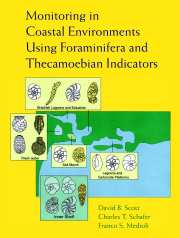Book contents
3 - Applications
Published online by Cambridge University Press: 18 August 2009
Summary
This chapter is intended to facilitate an understanding of how foraminifera and thecamoebians can help in evaluating marine-related environmental questions. Many of the diagrams presented have been simplified from the original for demonstrative purposes.
SEA-LEVEL CHANGES
Definitive Assemblages
Many workers have used foraminifera as sea-level indicators (see Haynes, 1981, for a review) but, prior to 1976, their resolution was limited to plus or minus several meters, especially if offshore assemblages were used. The assemblages described here should provide an accuracy of plus or minus a few centimeters at best, and 50 cm at worst. In 1976, the absolute accuracy of salt marsh foraminiferal vertical zonations was verified in southern California (Scott, 1976a) and later compared on a worldwide scale (Scott and Medioli, 1978, 1980b). Since that time, much more work has been done to verify that the relationship exists everywhere (e.g., Petrucci et al., 1983; Patterson, 1990; D. K. Scott and Leckie, 1990; Jennings and Nelson, 1992; Gehrels, 1994; deRijk, 1995; Horton et al., 1999a,b). It appears that the same eight to ten species of marsh foraminifera are ubiquitous throughout the world's salt marshes, especially in the upper half of the marsh. The reason salt marshes in general, and marsh foraminiferal zones in particular, have been used widely for sea-level studies is that the entire marsh environment is confined to the upper half of the tidal range (Chapman, 1960). For most tidal ranges this means that the whole vertical range of the salt marsh deposit is 1 meter or less.
- Type
- Chapter
- Information
- Publisher: Cambridge University PressPrint publication year: 2001

